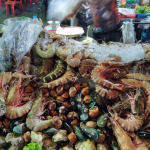
Eating in Thailand isn’t just about what’s on the plate—it’s about how you eat it. Thai people take pride in their culinary culture, and there’s a rhythm, etiquette, and unspoken rulebook that locals follow. Whether you’re dining in a Bangkok alleyway or a countryside family home, knowing how to eat Thai food like a local enhances both your experience and appreciation for the culture.
This comprehensive guide offers all the local wisdom you need to eat Thai food the right way, from table manners to utensil usage to flavor balancing.
Understanding Thai Food Culture
Thai cuisine is built around harmony—balancing sweet, sour, salty, bitter, and spicy flavors in every meal. But the way food is eaten is just as important.
-
Meals are communal and meant to be shared.
-
Dining is typically relaxed, social, and often informal.
-
Meals are eaten slowly, allowing everyone to taste a variety of dishes.
“Eating is not just nourishment in Thailand—it’s connection, hospitality, and identity.”
Utensils: Fork and Spoon, Not Chopsticks

Contrary to popular belief, chopsticks are not commonly used in everyday Thai meals.
-
Thais use a fork and spoon, with the spoon in the dominant hand.
-
The fork is used to push food onto the spoon, not into the mouth.
-
Chopsticks are mainly used for Chinese-style noodle dishes or stir-fried noodles like Pad See Ew and Pad Thai.
In Thailand, ordering “your own dish” is rare. Instead, everyone shares everything on the table.
-
Dishes are placed in the center and eaten with individual plates of rice.
-
It’s polite to take small portions and go back for more later.
-
Avoid mixing all dishes on your rice plate—try a little of each separately.
“Thai meals are like conversations—best enjoyed together and in balance.”
Rice First, Curry Second
When serving yourself, always start with steamed jasmine rice on your plate. Then, spoon a bit of curry, stir-fry, or soup over the rice.
-
Rice is the base of the meal and not meant to be eaten alone.
-
You won’t find curry bowls meant to be consumed like a soup.
-
Thais rarely drench their rice; just a modest amount enhances flavor.
Respect the Thai Spice Level

Many Thai dishes can be extremely spicy for foreigners. Locals are used to the heat, but you don’t have to suffer.
-
Use the phrase “Mai phet” (not spicy) if you’re unsure.
-
If you’re feeling adventurous, say “Phet nit noi” (a little spicy).
-
Balance spice with sides like sticky rice, cucumber, or sweet Thai tea.
Explore our Beginner’s Guide to Spicy Thai Food
Fish Sauce Is Life
On every Thai table, you’ll find a set of condiments known as “Kruang Prung”. This includes:
-
Nam Pla Prik (fish sauce with chopped chilies)
-
Sugar
-
Chili flakes
-
Vinegar with chilies
Thais adjust flavors themselves—don’t be shy to customize your dish with these condiments.
Eat with Your Hands? Sometimes Yes
In Northern and Northeastern Thailand (Isaan), sticky rice (khao niao) is eaten with the hands.
-
Roll rice into small balls and dip it into sauces or pair it with grilled meats.
-
Use only your right hand, and avoid double-dipping.
-
This method is traditional and deeply rooted in Thai village culture.

What Not to Do While Eating Thai Food
Thai dining etiquette is relaxed, but there are still cultural no-nos.
-
Don’t stick your fork in your mouth—use it only to push food.
-
Don’t blow your nose at the table, no matter how spicy the food.
-
Don’t waste rice—it’s seen as disrespectful to the farmer’s work.
How Thais Order Meals When Eating Together
Thais tend to order a variety of dishes that balance flavors and textures. A typical shared meal includes:
-
One curry (like Gaeng Keow Wan)
-
One stir-fry (such as Pad Kra Pao)
-
One soup (Tom Yum or Tom Kha)
-
A fried item or grilled dish (Gai Yang or Pla Tod)
-
Vegetables and dipping sauces (Nam Prik)
Learn more about traditional Thai meal structure
Typical Meal Times in Thailand
-
Breakfast: Usually rice soup (Jok) or fried rice.
-
Lunch: A light meal like noodles or stir-fry with rice.
-
Dinner: The main event, often with multiple dishes shared by family or friends.
-
Snacking: Very common. Thai people snack throughout the day on fruit, grilled meats, or sweets.
Understanding Thai Food Etiquette for Tourists
-
It’s okay to slurp noodles—it’s not considered rude.
-
Thank your host with a “Khob khun mak kha/khrab” after eating.
-
Many Thai homes ask guests to remove shoes before entering.
“Good manners are just as important as good flavor in Thai food culture.”
FAQs: Eating Thai Food the Local Way
Can I ask for custom spice levels at restaurants?
Absolutely. Just say “Mai phet” (not spicy) or “Phet nit noi” (a little spicy).
Is it rude to leave food on the plate?
Wasting food, especially rice, is considered disrespectful.
Do locals eat dessert after meals?
Not always. Thai desserts like mango sticky rice are often enjoyed between meals or with street snacks.
Are tips expected at local restaurants?
Not required, but rounding up or leaving small change is appreciated.
Conclusion: Taste Thai Food with Heart and Respect

Eating like a local in Thailand isn’t about imitation—it’s about understanding the rhythm of the culture. From the fork-and-spoon etiquette to the communal dining spirit, these traditions offer insight into how Thai people live, connect, and care for one another through food.
Remember: the best meals in Thailand are shared, seasoned by smiles, and savored slowly.
Want more Thai food wisdom? Visit Angel-Telecom.com for authentic guides, insider tips, and the tastiest street food trails across the Land of Smiles.


